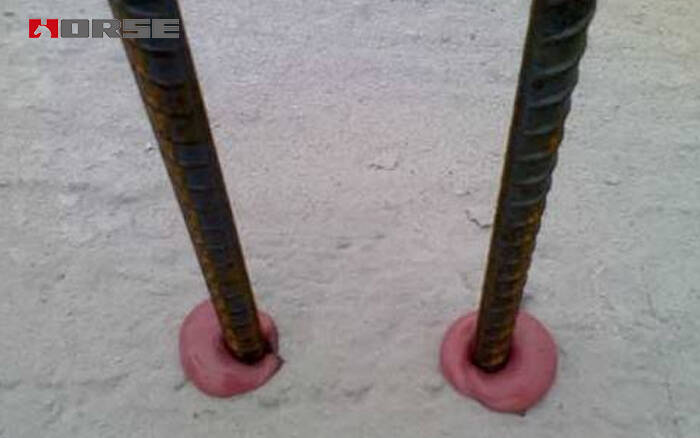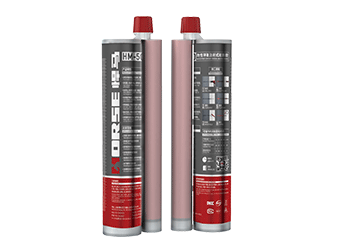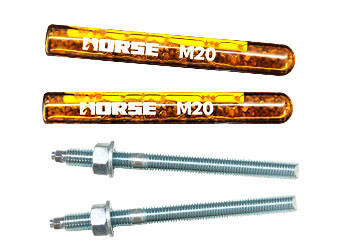Solutions
Horse Construction offers full range of structural strengthening materials with technical supports, documentation supports, products supports, project supports.
The bond between reinforcing bar and base material mainly depends on the adhesive force of chemical anchoring adhesive. Therefore, when selecting the hole diameter, the diameter of the rebar should be slightly larger than the diameter of the reinforcing bar, so as to ensure that the planting bar glue has a certain thickness to provide enough cohesive force.

1.Borehole aperture
The bond between reinforcing bar and base material mainly depends on the adhesive force of chemical anchoring adhesive. Therefore, when selecting the hole diameter, the diameter of the rebar should be slightly larger than the diameter of the reinforcing bar, so as to ensure that the planting bar glue has a certain thickness to provide enough cohesive force. The increase of pore diameter can increase the pulling force of planting bar in a certain range. In practical engineering, because of the smaller elastic modulus of the binder, the increase of the pore size will lead to the increase of the structural system slip. This will not only increase the amount of adhesive agent and the difficulty of drilling, but too large drilling will reduce the strength of the original structure and cause more damage.
Therefore, it is considered that the diameter of the drill diameter D is generally taken into consideration by considering the creep of the reinforcing bar, the difficulty of planting reinforcement and the economy and so on.
2. Diameter of steel bar
The diameter of reinforcement is the main factor determining the number of planting bars. The diameter of reinforcement should be determined according to the actual situation.
In the GB 50367 - 2006 "code for the design of concrete structure reinforcement", the formula for the design value of the axial tensile bearing capacity of a single steel bar, therefore, the number of rebar planting can be preliminarily calculated by the upper type: the larger the A, the n can be reduced accordingly. Fewer planting bars can reduce damage to the original structure, but the corresponding borehole diameter will also become larger.
When selecting the diameter of the steel bar, it is not allowed to determine its type at will. In the structure of rebar planting, the diameter of the steel bar should not be larger than the minimum number of rebars required by the N in the 32mm type, and the n will generally increase greatly because of the requirements of the shear resistance and the safety of the steel.

3.Depth of rebar planting
Planting depth is the most important factor affecting the effect of rebar planting. The tensile strength of steel bar is mainly provided by the bond force between the reinforcing bar and the adhesive glue and the bond force between the concrete and the adhesive glue. Therefore, the depth of the planting bar directly determines the pulling force and the form of the failure of the rebar. In order to make the structure safe, it is necessary to ensure that the form of the damage is a conical and one bond composite failure, that is, the slip of the steel bar and the base material, and thus the mixing interface is pulled out and the reinforcement is yielded. It can give full play to the tensile strength of steel bars without brittle failure. When the pyramidal bond is destroyed, the ultimate pulling force P is composed of the tensile Pc of the cone part of the planting bar and the two part of the bonding force between the bottom end anchor solid and the concrete.
4.Spacing of rebars
The effect of reinforcement spacing on the rebar planting effect is mainly reflected in two aspects: the spacing between reinforcing bars and the distance between reinforcing bar and base material edge.
1) two steel bar spacing will reduce the overall pullout resistance of sandalwood.
As far as multi root reinforcement is concerned, due to the close spacing, the range of anti pulling force between planting and rebar will overlap, so that the pulling resistance of each single plant can not be fully played. Therefore, when the planting bar is designed and constructed, the distance between the rebars should be guaranteed to be greater than 10d. In special cases, it is also necessary to ensure that the spacing of the planting bars is more than 4D, otherwise the increase of the reinforcement of the rebars will not be improved, but the unnecessary damage to the structure will be caused by more drilling holes. When the spacing between planting bars is between 2D and 10d, the reduction factor of 50%-90% should be multiplied to ensure that the total pullout resistance meets the requirements.
2) the steel bar is too close to the edge of the substrate, which will have some influence on the original structure performance.
If the thickness of the protective layer in the raw material is too small, the drilling or the compression member may be split due to the larger shear force, so the thickness of the protective layer should not be small 5D. The greater the thickness of the protective layer, the better. But for the original base material, the thicker the protective layer is, the better the bond anchorage, durability and fire resistance of the reinforced bar, but it will make the crack width too large and affect its performance, and the overthickness of the protective layer will affect the layout of the rebar, which leads to the decrease of the spacing between the rebars and the shadow. Sound reinforcement effect.
Therefore, the thickness of the protective bar for reinforcing bars in the structural reinforcement should not be greater than 15d.
You can find anything here you are in need of, have a trust trying on these products, you will find the big difference after that.

two-components modified epoxy resin adhesive, with high quality plastic tube, double cartridge package

High-strength anchor bolt with vinyl resin as main materials, composed of selected quartz sands, curing agents and glass tubes

Two-component modified epoxy resin adhesive, applied to chemical planting reinforcing bar and anchor bolt anchoring